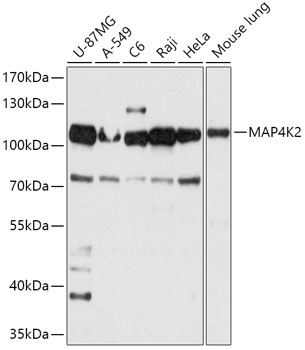| UniProt Protein Function: | GCK: Serine/threonine-protein kinase which acts as an essential component of the MAP kinase signal transduction pathway. Acts as a MAPK kinase kinase kinase (MAP4K) and is an upstream activator of the stress-activated protein kinase/c-Jun N-terminal kinase (SAP/JNK) signaling pathway and to a lesser extend of the p38 MAPKs signaling pathway. Required for the efficient activation of JNKs by TRAF6-dependent stimuli, including pathogen-associated molecular patterns (PAMPs) such as polyinosine-polycytidine (poly(IC)), lipopolysaccharides (LPS), lipid A, peptidoglycan (PGN), or bacterial flagellin. To a lesser degree, IL-1 and engagement of CD40 also stimulate MAP4K2-mediated JNKs activation. The requirement for MAP4K2/GCK is most pronounced for LPS signaling, and extends to LPS stimulation of c-Jun phosphorylation and induction of IL-8. Enhances MAP3K1 oligomerization, which may relieve N-terminal mediated MAP3K1 autoinhibition and lead to activation following autophosphorylation. Mediates also the SAP/JNK signaling pathway and the p38 MAPKs signaling pathway through activation of the MAP3Ks MAP3K10/MLK2 and MAP3K11/MLK3. May play a role in the regulation of vesicle targeting or fusion. regulation of vesicle targeting or fusion. Interacts with TRAF2, TRAF6, MAP3K1/MEKK1 and MAP3K11/MLK3. Interacts with RAB8A. Highly expressed in germinal center but not mantle zone B-cells. Also expressed in lung, brain and placenta and at lower levels in other tissues examined. The tumor necrosis factor (TNF), as well as endotoxins and proinflammatory stimuli such as polyinosine- polycytidine (poly(IC)), lipopolysaccharides (LPS), peptidoglycan (PGN), flagellin, or lipid A activate MAP4K2 by promoting its autophosphorylation. Belongs to the protein kinase superfamily. STE Ser/Thr protein kinase family. STE20 subfamily. |
| UniProt Protein Details: | Protein type:Motility/polarity/chemotaxis; Protein kinase, STE; Kinase, protein; Protein kinase, Ser/Thr (non-receptor); EC 2.7.11.1; STE group; STE20 family; KHS subfamily Chromosomal Location of Human Ortholog: 11q13 Molecular Function:ATP binding; mitogen-activated protein kinase kinase kinase binding; protein binding; protein serine/threonine kinase activity; receptor signaling protein serine/threonine kinase activity Biological Process: activation of JNK activity; immune response; JNK cascade; positive regulation of JNK cascade; protein amino acid phosphorylation |
| NCBI Summary: | The protein encoded by this gene is a member of the serine/threonine protein kinase family. Although this kinase is found in many tissues, its expression in lymphoid follicles is restricted to the cells of germinal centre, where it may participate in B-cell differentiation. This kinase can be activated by TNF-alpha, and has been shown to specifically activate MAP kinases. This kinase is also found to interact with TNF receptor-associated factor 2 (TRAF2), which is involved in the activation of MAP3K1/MEKK1. Alternative splicing results in multiple transcript variants. [provided by RefSeq, Apr 2015] |
| UniProt Code: | Q12851 |
| NCBI GenInfo Identifier: | 215274019 |
| NCBI Gene ID: | 5871 |
| NCBI Accession: | Q12851.2 |
| UniProt Secondary Accession: | Q12851,Q86VU3, |
| UniProt Related Accession: | Q12851 |
| Molecular Weight: | 90,809 Da |
| NCBI Full Name: | Mitogen-activated protein kinase kinase kinase kinase 2 |
| NCBI Synonym Full Names: | mitogen-activated protein kinase kinase kinase kinase 2 |
| NCBI Official Symbol: | MAP4K2 |
| NCBI Official Synonym Symbols: | GCK; BL44; RAB8IP |
| NCBI Protein Information: | mitogen-activated protein kinase kinase kinase kinase 2 |
| UniProt Protein Name: | Mitogen-activated protein kinase kinase kinase kinase 2 |
| UniProt Synonym Protein Names: | B lymphocyte serine/threonine-protein kinase; Germinal center kinase; GC kinase; MAPK/ERK kinase kinase kinase 2; MEK kinase kinase 2; MEKKK 2; Rab8-interacting protein |
| Protein Family: | Mitogen-activated protein kinase kinase kinase kinase |
| UniProt Gene Name: | MAP4K2 |
| UniProt Entry Name: | M4K2_HUMAN |







